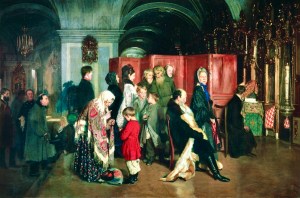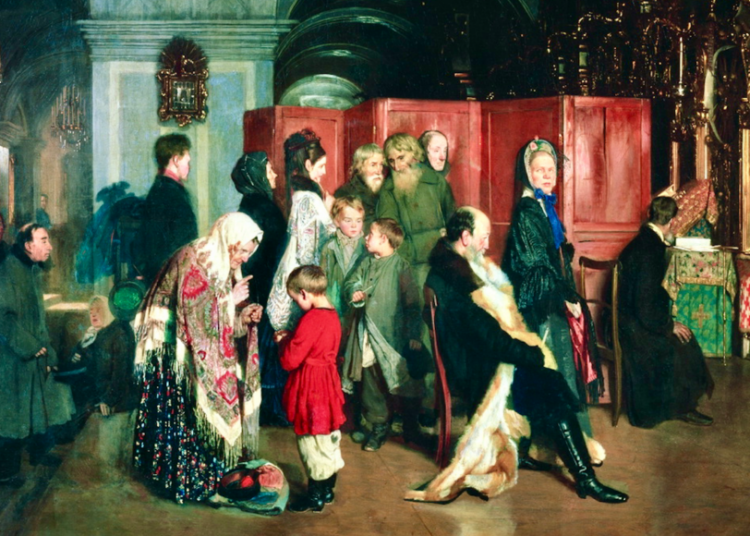The current practice of the Roman Church reflects that Lent is both penitential and baptismal. The penitential themes are predominant during the first two weeks. The baptismal elements are emphasized in a three-week Lenten period. The final two weeks are dominated by preparation for the celebration of the passion.
 At first glance, the season of Lent does not have one clear, predominant theme. For a catechumen, the purpose of the season of Lent is baptismal preparation. This season is a time when the whole Church joins in prayer as the catechumens go through RCIA preparations, and the season’s climax is their eventual initiation at the Easter vigil. However, this theme is not always obviously present. For example, at a parish where no one is entering the Church, many of the catechetical elements of this season are omitted. In these situations, the season of Lent seems to merely be a time of prayer, fasting, and almsgiving. The season is a forty-day-long pre-paschal fast, climaxing at the lengthy Easter vigil with the anamnetic celebration of Christ’s resurrection. Which of these interpretations is correct? Is Lent fundamentally a catechetical preparation, or is it a paschal preparation? To answer these questions, we must examine the historical preparations for Easter and baptism.
At first glance, the season of Lent does not have one clear, predominant theme. For a catechumen, the purpose of the season of Lent is baptismal preparation. This season is a time when the whole Church joins in prayer as the catechumens go through RCIA preparations, and the season’s climax is their eventual initiation at the Easter vigil. However, this theme is not always obviously present. For example, at a parish where no one is entering the Church, many of the catechetical elements of this season are omitted. In these situations, the season of Lent seems to merely be a time of prayer, fasting, and almsgiving. The season is a forty-day-long pre-paschal fast, climaxing at the lengthy Easter vigil with the anamnetic celebration of Christ’s resurrection. Which of these interpretations is correct? Is Lent fundamentally a catechetical preparation, or is it a paschal preparation? To answer these questions, we must examine the historical preparations for Easter and baptism.
The Early Church and Paschal and Baptismal Preparations
Before Lent was properly a season, a short fast was observed before the Easter feast in Rome and throughout the Western Church. In the early records of Eusebius, St. Irenaeus, and Hippolytus, the length of this period varied between one day and one week. This short period is not Lenten fasting; rather, it is the pre-Paschal fast—the roots of Holy Week and the Triduum. Similarly, a period of fasting was observed as part of baptismal preparation. Early Church writers like Justin Martyr and Tertullian emphasized the importance of fasting and praying for those preparing for baptism. The duration of these fasts varied, just like the pre-Paschal fasts.
The Emergence of the Three-Week Fast
A pivotal moment in the history of Lent occurred when a three-week fasting period was first introduced in Rome, a practice initially documented by Socrates Scholasticus around 439. This period is also evidenced by the vacancy of entries in the Deposito Martyrium (oldest calendar of martyrs) from March 7th – May 19th; this vacancy allows for a three-week Lent and a fifty-day Easter season. Some theologians further this evidence by pointing out that the earliest possible day for Easter is March 22nd, exactly three weeks after the start of the Roman New Year. This three-week “Lent” was not always linked to Easter. In its primitive state, it was primarily associated with baptismal preparation.
This three-week period was initially a “free-floating” baptismal preparation time, not tied to the liturgical year. There are records of this in the liturgical history of Rome, Jerusalem, Armenia, North Africa, Spain, Naples, and Constantinople. Only after baptism became associated with Easter the three-week fast was solidified on the calendar before Easter. This period eventually extended to the now-familiar forty-day Lent.
The Establishment of the Forty-Day Fast
The formal recognition of a forty-day fasting period can be linked to the Council of Nicaea in 325. Shortly after the council, under the influence of St. Athanasius, the church in Alexandria observed this six-week Lent as a preparation for Easter. Following the Council of Nicaea’s decree, the Bishop of Alexandria announced the date of Easter every year. In these announcements, St. Athanasius occasionally stated the start date of the pre-paschal fast; while the length of these fasts varies in the festal epistles, he often states that the fast should last forty days as a preparation for Easter.
The consensus of modern Liturgical theologians is that the fast of forty days must have first appeared in Rome between 354 and 384. This is argued because the forty-day Lent was not recorded in the Deposito Martyrium (354) but was mentioned in Jerome’s letter about St. Asella (384). St. Asella was an ascetic in Rome who was inspired to embrace this life of solitude and fasting when she heard St. Athanasius speak during his third visit to Rome. At the time of his visit to Rome, the Alexandrian Church had already established the observance of a forty-day fast as a preparation for Easter. The Roman church quickly followed suit.
The forty-day fast is also evidenced as both a Paschal and catechumenal preparation in Rome in 385 by a decree of Pope Siricius. In this decree, Pope Siricius set Easter as the primary day for baptism and decreed that those to be baptized must prepare “quadraginta dies vel amplius” (forty days or more). Thus, the Lent of forty days formed around the—no longer free-floating—three-week baptismal fast.
The season of Lent developed from two intersecting traditions: pre-baptismal preparation and pre-Paschal preparation. Both of these traditions can be traced back to the early Church. Both seasons grew simultaneously until the preference for Baptism at Easter was formalized. At this point, the three-week pre-baptismal fast was grafted over the pre-paschal fast, and the season of Lent was born.
Modern Practice in the Roman Church
The current practice of the Roman Church follows both of these original themes—Lent is both penitential and baptismal. The penitential themes are predominant during the first two weeks. The baptismal elements are emphasized in a three-week Lenten period. The final two weeks are dominated by preparation for the celebration of the passion. Together, these stages form the essential thematic framework of the season of Lent.
The Imaginative Conservative applies the principle of appreciation to the discussion of culture and politics—we approach dialogue with magnanimity rather than with mere civility. Will you help us remain a refreshing oasis in the increasingly contentious arena of modern discourse? Please consider donating now.
The featured image is “Before Confession” (1876) by Alexey Ivanovich Korzukhin, and is in the public domain, courtesy of Wikimedia Commons.


